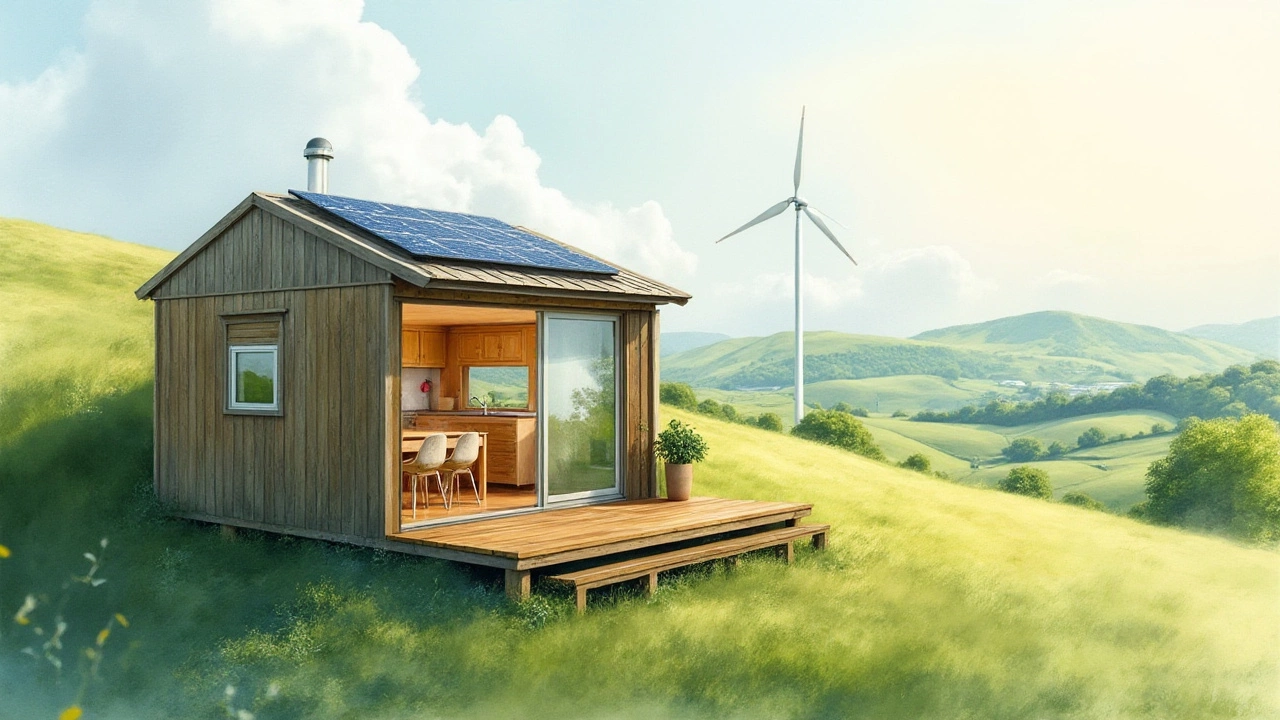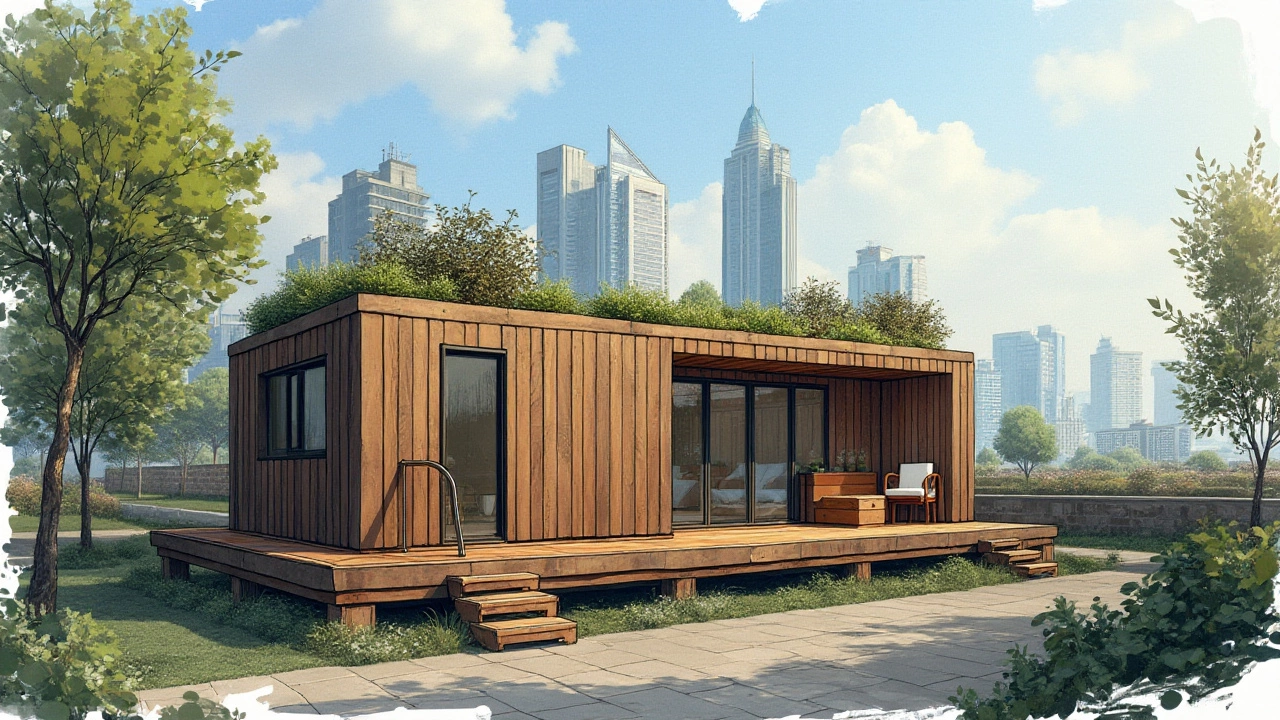Exploring the Eco-Friendly Nature of Tiny Houses

In a world increasingly aware of environmental challenges, the tiny house movement has emerged as a beacon of sustainable living. These petite dwellings, often characterized by their clever design and compact spaces, stand in stark contrast to the conventional notion of home ownership. By intentionally occupying less space, tiny houses urge us to reconsider our lifestyle choices and our relationship with the environment.
Tiny houses significantly cut down on resource use, from the materials needed for construction to the energy consumed daily. By opting for sustainable materials and incorporating renewable energy sources, these homes reduce environmental impact and carbon footprint. Additionally, the minimalist lifestyle promoted by tiny houses encourages mindful consumption and waste reduction.
This shift towards smaller, more sustainable living spaces also has a profound effect on individuals and communities. It fosters a sense of connection, both to the world around us and to each other, as residents often find more time and resources to engage with their surroundings. With thoughtful and eco-friendly living at its core, the tiny house movement continues to inspire a new generation of homeowners seeking a more sustainable future.
- The Rise of Tiny Houses
- Sustainable Design Features
- Living Efficiently with Less
- Impact on Environment and Community
The Rise of Tiny Houses
Over the past decade, the tiny house movement has grown from a niche trend to a widespread revolution in housing. This shift is fueled by a combination of economic pressures, environmental concerns, and a growing desire for a more minimalistic lifestyle. As housing prices soar in urban areas around the world, many people find themselves priced out of traditional home ownership. Enter the tiny houses — compact, affordable, and flexible living spaces that offer a viable alternative.
The appeal of tiny houses is not just financial; they also represent a profound shift in how we perceive home and personal space. With an average size ranging from 100 to 400 square feet, these homes require clever layouts and innovative storage solutions. This often means personalized, creative designs that evoke a sense of freedom and individuality. In embracing minimalistic lifestyle, people are realizing that less truly can be more, finding joy in simplicity and possessions that bring meaningful value.
Environmental benefits are a significant driving force behind the movement. Constructing a tiny home requires fewer resources and results in a notably smaller carbon footprint. Many enthusiasts opt for sustainable options, such as solar panels or composting toilets, to make their living more eco-friendly. These houses are often constructed from recycled or natural materials. According to a report by the American Tiny House Association, owners typically use 45% less energy compared to those in average-sized homes.
Let's not forget the cultural influencers who play a role in the popularity of tiny homes. From television shows to social media, the world has taken a keen interest in this lifestyle. Shows like "Tiny House Nation" and "Tiny House Hunters" have brought the concept into mainstream consciousness, sparking curiosity and imagination in potential homeowners.
"Tiny houses symbolize the essence of sustainable living without sacrificing comfort," notes author and sustainability advocate, Sarah Alvord.
Finally, the rise of tiny houses also highlights a societal shift toward community-oriented living. People are increasingly keen on joining tiny house communities, which are often sited in rural settings or as urban infill projects. These communities offer a sense of belonging, shared values, and mutual support. This collective living brings not just practical resources but a shared commitment to lower-impact living, aligning with broader trends in sustainable living.
Sustainable Design Features
When it comes to crafting an eco-friendly living space, tiny houses shine brightly with their innovative, sustainable design features. These homes are meticulously planned to make the most out of minimal resources, embodying a philosophy of efficiency and respect for the environment. Their compact nature means there's less room to heat and cool, which naturally reduces energy consumption. Many of these small homes are equipped with solar panels, allowing them to harness renewable energy directly from the sun. This not only cuts down on electricity costs but drastically minimizes the carbon footprint of the inhabitants, contributing to a more sustainable lifestyle.
Water conservation is another critical aspect of sustainable design in eco-friendly homes. Tiny houses often include rainwater harvesting systems, allowing homeowners to collect and utilize rainwater for non-potable uses, such as irrigation or flushing toilets. Greywater systems can also be installed to treat water from showers and sinks, making it available for reuse. These systems significantly lower the demand on local water supplies and encourage responsible water usage, which is vital in areas experiencing water scarcity. The commitment to sustainability is woven into the fabric of these homes, underlying their core appeal to environmentally conscious individuals.
The choice of building materials plays a pivotal role in the sustainability of these homes. Many builders opt for reclaimed or recycled materials, giving new life to resources that would otherwise end up in landfills. Using such materials not only reduces the environmental impact of new production but brings a unique, charming character to each home. Bamboo is another popular choice due to its rapid growth rate and tensile strength, making it an ideal sustainable resource. The emphasis here is on creating a safe, aesthetically pleasing space that reflects both environmental responsibility and personal style.
In a fearlessly inventive approach, tiny houses are often designed with multi-functional furniture and convertible spaces that maximize every square inch of the living area. For instance, a dining table might also serve as a work desk, or a bed might fold into a wall to free up space during the day. This clever use of space ensures that the homes remain comfortable and livable, despite their reduced footprint, and highlights a core principle of the minimalistic lifestyle: owning only what you truly need. "The essence of a tiny house is efficiency, not deprivation," remarks architect Marjanne Pearson, emphasizing the delicate balance between comfort and functionality.
Adopting these sustainable living practices in tiny homes isn't just about technology or clever engineering; it's about reshaping how people think about their impact on the planet. Residents often find that living in a tiny house fosters a closer connection to the natural world around them, as they become more conscious of their resource consumption and waste production. This growing awareness can inspire further positive actions, fostering a holistic approach to sustainability that extends beyond the confines of the home itself.

Living Efficiently with Less
Embracing a lifestyle that revolves around tiny houses encourages the art of living efficiently with less, without compromising on comfort or quality of life. These compact dwellings demand a thoughtful approach to space utilization, where every square foot serves multiple purposes. It is fascinating to witness how inventive solutions can transform even the smallest rooms into highly functional living areas. Emphasizing quality over quantity becomes paramount as furnishings and appliances are carefully selected to ensure they fit seamlessly into the home’s design while meeting daily needs. This conscious decision-making fosters an environment that reduces clutter and promotes tranquility.
Not only does this way of living cut down on excess, but it also significantly lowers expenses, making it an economically wise choice. Reduced utility bills are a direct consequence of fewer energy demands, and for many, this translates into financial freedom and less time spent at work. This newfound liberation allows individuals to invest in experiences, education, and hobbies, enriching their lives rather than collecting possessions. "In my tiny house, I've found richness in simplicity," shares celebrated architect Sarah Susanka in her influential book,
"The Not So Big House."
Integrating eco-friendly technologies into these homes allows residents to maximize their benefits. Innovative insulation materials, energy-efficient fixtures, and renewable energy solutions not only minimize the ecological impact but also enhance the overall living experience. Consider a small-scale solar power system, which can be a game-changer, providing ample energy for day-to-day activities. Rainwater harvesting and composting toilets are other common features, reducing dependence on municipal resources. These features align perfectly with a desire to tread lightly on the earth.
An interesting fact about the minimalistic lifestyle associated with tiny houses is that it often leads to a decluttering of both physical space and mental load. As material items take up less physical room, the mind is afforded more space to focus on moments, relationships, and personal growth. Tiny house enthusiasts often report feeling a sense of freedom and clarity that comes with shedding the unnecessary. Support networks and online communities have sprung up around this movement, offering inspiration, stories, and advice for those who wish to explore living with less and making it efficient and fulfilling.
Impact on Environment and Community
When delving into the world of tiny houses, their impact on both the environment and the communities they occupy becomes remarkably apparent. These small dwellings have a profound ability to reshape not only our landscapes but also the fabric of our societies. By consuming fewer resources in construction and operation, tiny houses help conserve nature. The reduced need for building materials, such as wood, concrete, and metals, translates directly into decreased deforestation and mining activities. This conscious choice in housing leads to a significant decrease in emissions, both in terms of production and through minimized energy consumption during their lifespan.
Additionally, tiny houses often incorporate innovative technologies to enhance their sustainable living practices. Many of these homes are equipped with solar panels, rainwater harvesting systems, and composting toilets, which contribute to a self-sufficient lifestyle. By emphasizing the use of renewable energy and sustainable water management, tiny houses play an active role in environmental preservation. An interesting aspect of these homes is their mobility, which allows for flexibility without the commitment to one single geographical location. This adaptability can mitigate the impact on any given environment by preventing the long-term overuse of local natural resources.
Communities that embrace tiny houses often experience a rejuvenation of sorts, as these homes promote a stronger sense of community among residents. The shared vision of living minimally and sustainably can foster closer bonds between neighbors, encouraging collaboration in community gardens or solar power projects. These efforts not only benefit individuals by reducing living costs but also enhance the social fabric through collective initiatives. By living in closer proximity, occupants of tiny houses can redefine the idea of neighborhood, leading to reduced transportation needs and greater reliance on local resources, which further diminishes the community’s ecological footprint.
The appeal of minimalistic lifestyle extends beyond environmental concern; it drives social innovation. With fewer possessions and smaller living spaces, individuals are often inspired to engage more with their surroundings, participating in local culture, and supporting small businesses. It’s in these communities that tiny houses truly shine, turning everyday living into an intentional act of environmental stewardship. For example, in one community in Oregon, tiny house clusters have revitalized local towns, enticing new visitors and entrepreneurs who appreciate the commitment to eco-friendly practices. Such transformation speaks to the power of changing our housing norms to better align with sustainable and community-oriented goals.
"Tiny homes are not just about living small, but about living better," states Bill Johnson, renowned environmental advocate and author. "Their existence challenges our traditional perspectives on space, consumption, and interconnectedness."
The ripple effects of adopting eco-friendly homes like tiny houses extend well beyond the individual household. By serving as a living model of sustainability, tiny house communities inspire broader environmental consciousness. This shift towards more sustainable choices has the potential to influence urban planning policies, encouraging other communities to adopt similar sustainable practices. As more people witness how such small changes can yield large benefits, momentum builds for long-term change, illustrating perfectly how tiny can indeed mean mighty when it comes to impacting our world positively.